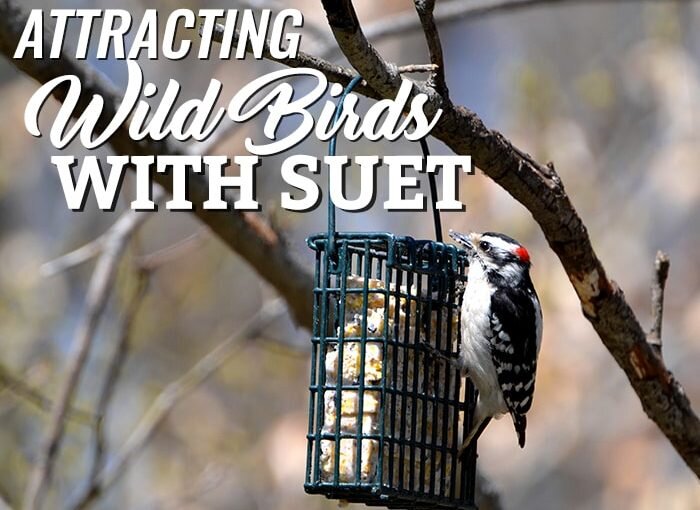How to attract wild birds to your backyard year-round with suet treats.
 Suet was once something we stocked in our backyard feeders only in the winter months. Today’s suet formulations can be used all year-round to benefit birds in your neighborhood.
Spring & Summer - It meets the increased energy demands of nesting birds. In the summer months, it provides a good substitute for insect-eating birds, especially in years when insects are not very plentiful.
Fall & Winter - Helps wild birds store fat to prepare for migration or the coming winter. In winter, suet replenishes depleted stores of energy and nutrients, to help birds survive the long, cold months.
Nature's Nuts bird suets’ main ingredient is beef fat. Fat plays a very important role in both human and avian diets. Along with protein and carbohydrates, fat is one of the three dietary sources of calories - or energy. Fats are concentrated forms of energy and, per unit weight, provide more than twice the caloric energy as protein or carbohydrates of equivalent weight. This is very important for birds because their metabolisms are extremely accelerated. Fat energy helps them sustain activity levels longer between meals. So, bring out the suet!
In addition to fat, today's suet is formulated with much more. It offers ingredients such as seeds, fruits, and insects. You can even get melt-resisting varieties for less mess in summer or suet made from vegetable fat, which tends to resist rancidity better than animal fat varieties. These diverse blends make suet more palatable to a greater variety of species, and they also provide better overall dietary benefits than rendered animal fat alone - any time of the year. Find suet in the form of cakes, balls, or logs.
Suet was once something we stocked in our backyard feeders only in the winter months. Today’s suet formulations can be used all year-round to benefit birds in your neighborhood.
Spring & Summer - It meets the increased energy demands of nesting birds. In the summer months, it provides a good substitute for insect-eating birds, especially in years when insects are not very plentiful.
Fall & Winter - Helps wild birds store fat to prepare for migration or the coming winter. In winter, suet replenishes depleted stores of energy and nutrients, to help birds survive the long, cold months.
Nature's Nuts bird suets’ main ingredient is beef fat. Fat plays a very important role in both human and avian diets. Along with protein and carbohydrates, fat is one of the three dietary sources of calories - or energy. Fats are concentrated forms of energy and, per unit weight, provide more than twice the caloric energy as protein or carbohydrates of equivalent weight. This is very important for birds because their metabolisms are extremely accelerated. Fat energy helps them sustain activity levels longer between meals. So, bring out the suet!
In addition to fat, today's suet is formulated with much more. It offers ingredients such as seeds, fruits, and insects. You can even get melt-resisting varieties for less mess in summer or suet made from vegetable fat, which tends to resist rancidity better than animal fat varieties. These diverse blends make suet more palatable to a greater variety of species, and they also provide better overall dietary benefits than rendered animal fat alone - any time of the year. Find suet in the form of cakes, balls, or logs.
Suet Placement
Locate suet feeders at least five feet from the ground and close to a tree trunk. Most birds that enjoy suet are “clingers”; they cling to tree trunks in search of insects. The close proximity to the tree not only encourages suet feeding but also protects the suet from the sun's heat - a very important factor in summer months when suet quickly becomes rancid in the hot sun. Since suet is a coveted item, it is eaten rapidly once birds discover it. You will need to refill often, especially in the winter. Present suet in a cage feeder or specially made feeder. You can also place it inside a mesh bag, or simply rub it directly onto tree trunks and branches. You can even put suet balls on a fruit spike or skewer. Birds will find it. Before long, you'll see a steady stream of chickadees, woodpeckers, warblers, titmice, kinglets, nuthatches, jays, wrens, and other birds eagerly visiting your suet feeders.We would love to see your backyard birds, use #mywilcolife on Facebook, Twitter, or Instagram and tag Wilco Stores.
Orders
Services
About
Your Wilco Store
Store Hours
Monday to Saturday:
8 a.m. to 8 p.m.
Sunday: 9 a.m. to 6 p.m.
Need Help?
For questions or help with online orders call: (888) 78-WILCO
Limited to stock on hand. Some items may vary from photos. Because of store size limitations or geography, some items featured may not be available in all stores but will be made available by special order during sale periods at advertised prices. All sale prices listed as “dollars off” or “% off” are discounted from our regular posted shelf price, not from discounts given with specialty, bulk or pallet pricing. Reseller and Drop-shippers must contact us for pre-approval to place orders with the intent to re-distribute.
© 2025, Wilco Farm Store
